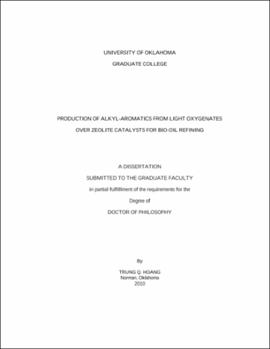| dc.description.abstract | Upgrading of light oxygenates derived from biomass conversion, such as propanal and glycerol, to more valuable aromatics for biofuels has been demonstrated on zeolite catalysts. Aromatics with a high ratio of C9/(C8+C7) and little benzene are produced at much higher yield from oxygenates than from olefins at mild conditions over HZSM-5. It is proposed that C9 aromatics are predominantly produced via acid-catalyzed aldol condensation. This reaction pathway is different from the pathway of propylene and other hydrocarbon aromatization that occurs via a hydrocarbon pool at more severe conditions with major aromatic products C6 and C7. In fact, investigation on the effect of crystallite size HZSM-5 has shown a higher ratio of C9/(C8+C7) aromatics on small crystallite. This is due to faster removal of products from the shorter diffusion path length. As a result, a longer catalyst lifetime, less isomerization, and less cracking were observed on small crystallites. Beside crystallite size, pore geometry of zeolites was also found to significantly affect aromatic production for both conversion of propanal and glycerol. It is shown that the structure of the HZSM-22, with a one-dimensional and narrower channel system, restricts the formation of aromatics. In contrast, a higher yield of aromatic products is observed over HZSM-5 with its three-dimensional channel system. By increasing channel dimension and connectivity of the channels, increasing catalyst activity was also observed due to more accessible acid sites. It was also found that glycerol is highly active for dehydration on zeolites to produce high yields of acrolein (propenal), a high value chemical. To maximize aromatics from glycerol conversion, HZSM-5 and HY were found to be effective. A two-bed reactor of Pd/ZnO and HZSM-5 was used to first deoxygenate/hydrogenate glycerol over Pd/ZnO to intermediate oxygenates that can further aromatize on HZSM-5. The end results are very promising with significant improvement in aromatic yield. Further improvement of aromatization and catalyst lifetime was also found with ZnHZSM-5 wherein the Zn evidently modifies the acidity. These model compound results show that the optimized use of zeolites for production of alkyl aromatics from light oxygenates at mild conditions may be effective for bio-oil refining. | |
